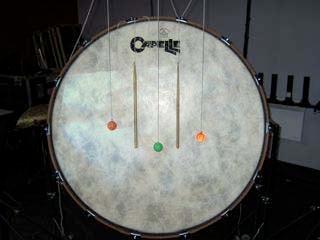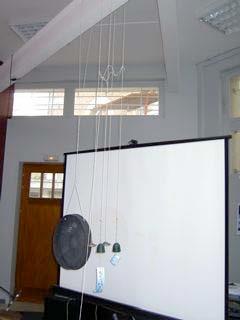NORDIN
Pendants
(2009)
Pendant I

ISSUU Version
For perusal only
ISSUU Version For perusal only
JESPER NORDIN Pendants
for ensemble and live electronics (and optional live video) (2009)
Pendant I
Unter der Nummer 12719a in die Edition Peters aufgenommen
EIGENTUM DES VERLEGERS · ALLE RECHTE VORBEHALTEN ALL RIGHTS RESERVED
HENRY LITOLFF’S VERLAG / C. F. PETERS
Ein Unternehmen der EDITION PETERS GROUP
FRANKFURT/M. · LEIPZIG · LONDON · NEW YORK
ISSUU Version
For perusal only
dedicated to Ensemble l’Itineraire
BESETZUNG / ORCHESTRATION
ISSUU Version For perusal only
Flute (also Alto Flute)
Clarinet (also Bass Clarinet)
Percussion (one player): Gran Cassa
(with three rubber balls and two drum sticks attached)
Tam-tam
(with three or four drum stick/brass mallets attached)
Gong
4-8 Crotales (or other small bells)
Piano / Midi Keyboard
Violin I
Violin II
Viola
Violoncello Contrabass
Commissioned by Ensemble l’Itinerare with the help of Rikskonserter/Concerts Sweden
Composed with technical assistance from Art Zoyd and Carl Faia
Premiered April 28:th 2009 at Auditorium St Germain in Paris by Ensemble l’Itinerare conducted by Dominique Dournaud
This version revised 2012-08-19
Aufführungsdauer / Duration: 29 Min. (Pendant I - 12 Min, Pendant II - 8 Min, Pendant III - 9 Min)
Aufführungsmaterial leihweise erhältlich / Orchestral material is available for hire
ISSUU Version
Specifications for the percussionist:
For perusal only
The Gran Cassa and the Tam -tam are to be prepared in the following way:
- The Gran Cassa should be tilted almost vertically but with an angle upwards of the front skin of about 5-10 degrees. This angle should allow the percussionist to play on both the back and the front skin (simultaneously and one at a time) and at the same time give the attached objects a good “bouncing angle”. The attached objects are three rubber balls (preferably in different colours) that are attached to the ceiling or to a high stand above the Gran Cassa. These three balls should be in contact with the front skin and should bounce when the drum is played. Apart from the rubber balls, two drum sticks should be attached to the Gran Cassa in a way so that they can hang freely without touching anything in the beginning and then be added to the front skin to add to the rattling sound of the rubber balls.
- The Tam-tam should be on the other side of the stage from the Gran Cassa and is never played directly by the percussionist. Behind the Tam -tam you put a speaker, as closely as possible. This speaker projects the sound of the Gran Cassa loud enough to get the Tam-tam to resonate. Attached to the Tam-tam is 3-4 drum sticks/bamboo chimes or brass mallets (or any combination of these). The overall sound should be a fast rattling when soft sounds are sent through the speaker and several clearly audible rhythmical layers from the different attachments when loud sounds are sent through.



The Crotales and/or Bells and the Gong at the back of the stage are to be hung up in strings and then played by attaching another string to the strings they are hanging on.
- The Crotales/Bells are to be hung in pairs of almost the same pitch so that th ey hit another Crotale/Bell of the same pitch when the string is pulled lightly, and then hit other Crotales/Bells when the string is pulled a little harder and finally hit the Gong when the string is pulled hard.
- The Gong is hanging by a separate string and can only be played by getting the Crotales/Bells to hit it. By pulling both the string of the Crotales/Bells and the string of the Gong it is possible to achieve some kind of control over the overall sound even if it’s impossible to have complete control.



Stage set up
ISSUU Version For perusal only

Technical equipment needed for Pendants:
Sound:
* Computer with Max/MSP and the patch "Pendants Audio"
* Sound card with minimum eight inputs and four outputs
* MIDI Keyboard
* One MIDI switch pedal
* Mixer (with possibility of sending submixes of the audio inputs to the computer)
* At least two speakers for the out sound (the piece works in stereo but can benefi t from more speakers to broaden the sound space)
* One speaker to put very close behind the Tam -tam
* One speaker to put under the grand piano (as close to the underside as possible)
* Monitors for the musicians and the conductor
* Microphones for all instruments in the ensemble (see sketch above for example, can be modified depening on the hall)
An example of the sound routing can look like this
Mixer inputs
* Microphones for all instruments
* 2, 4 or 6 channels of sound from the computer
Mixer outputs
* Main out to sound system (stereo or more)
* Aux send to monitors
* Direct send to computer of one G.C. mic, one Tam -tam mic, two of the Crotale/Bells/Gong microphones
* Submix of ensemble to computer (preferably two seperatly - one for Vla, Vlc and Cb and one for Fl, Cl, Vl1 and Vl2)
Sound card
Inputs (8): Direct sends and submixes from the Mixer
Outputs (4, 6 or 8): Direct to speaker behind Tam - Direct to speaker under Pf – 2, 4 or 6 outputs of the treated sound to the mixer
ISSUU Version
Video:
* Computer with Max/MSP/Jitter and the patch "Pendants Video"
* Three projectors – one of better quality to project on a big screen behind the scene, two of lesser quality to project on the Gran Cassa skin and on the surface of the Tam-tam.
For perusal only
* One big screen behind the ensemble
* Two, three or four camers – one fixed on the Gran Cassa, one (or two, then at different angles) on the Crotales/Bells and optionally one inside the Grand Piano
Video in Pendants is optional, but if all three movements are played it is definitely disirable.
Example images from workshop at Art Zoyd in Valenciennes:






Pendant I ISSUU Version
For perusal only
Hang three coloured rubber balls from a high stand and let them rest and rattle on the front skin
Ordinary G.C. mallets
(the keyboard part of Pendant I can also be played by a second percussionist)
Put a drum stick diagonally over the lowest string, then play with mallets directly on two or more of the lowest strings
sempre (it is very important the the pedal is held down when indicated in this movement since the sound from the ensemble is Routed to a speaker under the piano to get the resonance)
(numbers in squares represent different parts in the Max/MSP patch, to step forward press the foot switch)
square noteheads = no pitch **
square noteheads = no pitch **
square noteheads = no pitch **
square noteheads = no pitch **
square noteheads = no pitch **
(gradually faster tremolo)
(gradually faster tremolo) (gradually faster tremolo) (gradually faster tremolo)
(gradually faster tremolo)
- The sound from the G.C. is Routed to the speaker behind the Tam-tam
- Heterophony on ensemble (random delay between 2 and 8 sec.)
- Distortion on ensemble and on Heterophony (with an envelope follower before inlet to minimize feedback) (distortion is also recorded into Buffer P1:1)
* use a multiphonic based on the indicated pitch that blends with the ensemble sound
** stop the
only noise
For perusal only

ISSUU Version For perusal only
For perusal only

ISSUU Version For perusal only
ISSUU Version
For perusal only
ISSUU Version
For perusal only
ISSUU Version For perusal only
For perusal only
ISSUU Version For perusal only
ISSUU Version
For perusal only
ISSUU Version
For perusal only
ISSUU Version For perusal only
ISSUU Version
For perusal only
ISSUU Version
For perusal only
For perusal only
ISSUU Version For perusal only
For perusal only
ISSUU Version For perusal only
For perusal only
ISSUU Version For perusal only
ISSUU Version For perusal only
- Distortion is deactivated (gradually fades during 15 sec.)
- Heterophony activated on ensemble and distortion
For perusal only
Ordinary G.C. mallets
(°)
- Heterophony off
- Routing of all sound to speaker under Grand Piano
Envelope follower turned on, on both G.C and Tam projector. Sensitivity is gradually decreased.
For perusal only
ISSUU Version For perusal only
For perusal only
For perusal only
For perusal only
ISSUU Version
For perusal only

ISSUU Version For perusal only

ISSUU Version
For perusal only

ISSUU Version
For perusal only

ISSUU Version
For perusal only

ISSUU Version
For perusal only

